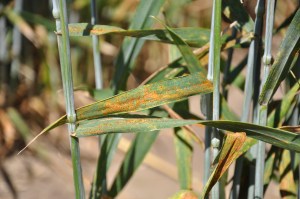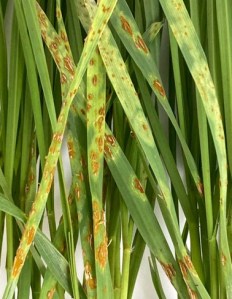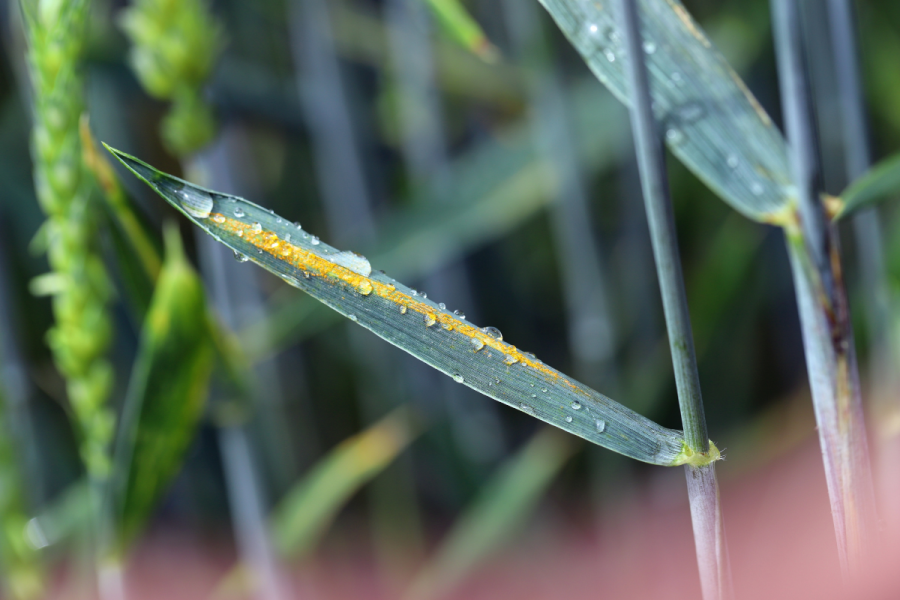The pathogen causing yellow rust has been changing its virulence profiles faster than you can say ‘variety resistance’ of late. CPM was at the UKCVPS stakeholder event last month to find out the status quo between winter wheat varieties and the pathogen in 2022.
“Of the 24 genotypes we found in testing, 23 of these were from the Red Group and just one was from the Pink Group.”
By Lucy de la Pasture
Although yellow rust is already making its mark in some crops this spring, there appears to be a calming of the waves, according to the results from last season’s UK Cereal Pathogen Virulence Survey (UKCVPS).
But that’s not to say that there’s a narrowing in diversity or that there aren’t virulence changes, there are, but change isn’t happening of the magnitude that caused choppy waters in 2011. That’s when the Warrior race (Pink Group) began to take over the population and some varieties soon broke down to yellow rust in spectacular fashion.

The most common pathotypes found in 2022 were Red 26 (28%) and Red 24 (20%). Both of these have been around since 2016 and Red 24 was the most common pathotype in 2017, explains Amelia Hubbard.
So what’s changed? Since 2017, the Red Group of yellow rust (formerly Warrior minus) has dominated the population and that didn’t change in 2022, according to NIAB’s Amelia Hubbard.
“Of the 24 genotypes we found in testing, 23 of these were from the Red Group and just one was from the Pink Group. The most common pathotypes we found in 2022 were Red 26 (28%) and Red 24 (20%). Both of these have been around since 2016 and Red 24 was the most common pathotype in 2017.”
The new kids on the block were Red 84, Red 85 and Pink 18 – all at 4% of the isolates tested. “Pink 18 is of particular interest as it has virulence for Crusoe,” adds Amelia.
The numbers assigned to the Red newcomers is an indication of just how much diversity now exists within this genetic group, which now extends to more than 80 different pathotypes with a large range of virulence profiles.
As breeders have responded to the increasing threat from yellow rust, genetics has caught up in the race – the AHDB Recommended List now boasts 18 winter wheat varieties with a yellow rust disease rating of 9. Strong resistance to one disease often comes at the expense of resistance to another and currently it’s brown rust that could prove to be the Achilles heel in some varieties – with just one having a resistance of 9 and two with a rating of 8.

Theodore was the anomaly in 2022, with brown rust overriding the Lr24 gene found in the South West.
On the whole, varieties appear to be performing in line with their RL rating for brown rust, according to the newly introduced AHDB watch list and UKCVPS trials. However, one of the varieties rated as an 8 for resistance to the disease, Theodore, stood out in an RL trial in Devon.
At the site, Theodore had a relatively high level of brown rust (18.8%) with only the notoriously brown rust susceptible variety Crusoe (3) having more disease (25.0%). The RL trial wasn’t the only Theodore anomaly noticed last year, UKCPVS received a brown rust sample from further down the coast in Dorset, ringing a few alarm bells that all may not be as it should.
“The sampler noted infection levels of 3%, in addition to relatively high disease levels (up to 10%) in foci, much higher than would be expected for a variety rated as an 8,” notes Amelia.
UKCPVS growth room screening tests conducted in 2022, suggest that the Dorset isolate may be able to unlock a specific resistance (leaf rust, Lr) gene – Lr24. Brown rust pathogens able to unpick the Lr24 lock haven’t been detected by UKCPVS since 2017. As a result, this isolate of interest will be included in adult plant trials to help determine its significance to varieties, she adds.
In general, Theodore has a reputation for being a strong performer against cereal rusts. In addition to its main ‘adult plant’ yellow rust rating of 9, it also resists yellow rust and brown rust at the young plant stage. The latter is a particular achievement – being the only variety on the current (RL 2023/24) list to possess this trait. It also appears to resist wheat stem rust.

In stem rust, the shredding epidermis is a characteristic of the disease and Theodore is the only variety able to resist infection.
Although stem rust isn’t the disease that first comes to mind when considering rust infections, UK conditions have become more conducive to stem rust infection over the past 25 years. In 2013, stem rust was recorded in UK crops for the first time in over 60 years and the disease has been spotted at different locations in subsequent years.
Although stem rust doesn’t usually come under the UKCVPS remit, two stem rust isolates were tested in 2022 on the full set of recommended and candidate varieties in seedling tests, explains Amelia.
Symptom development photos provide a clear picture of Theodore’s ability to check infection, notes Amelia, with only a slight pustule development which didn’t progress any further for the duration of the trial.
RGT Wolverine was also able to limit pustule development, but all the other winter wheat varieties were highly susceptible to the disease in these seedling tests. Amelia concludes by urging growers and agronomists to keep an eye out for stem rust and to send any samples to Prof Diane Saunders at the John Innes Centre for testing in 2023.
A variety mix-up?
Giving an Integrated Pest Management (IPM) perspective at the UKCVPS meeting, Lise Nistrup Jørgensen, from the Agroecology department at Aarhus University in Denmark, examines the benefits of variety mixtures.
Danish growers are leading the charge when it comes to making use of variety blends as an IPM tool, primarily to reduce fungicide usage and relieve selection pressure on both variety genetics and fungicides.

According to Lise Jørgensen, there won’t be any yield benefit from growing a variety mixture if the crop is “plastered with fungicide”.
The eight principles of IPM are set out under EU directive 2009/128/EC, which considers the sustainable use of plant protection products. The first of these principles is to ‘prevent attack’, using IPM measures, such as growing resistant cultivars or mixtures, and using other cultural methods which include delayed sowing, adjusting fertilisation or ensuring a crop rotation which minimize the overall need for pesticides, says Lise.
“Typically, when we compare a mixture in trials, we always take the average of the three components and then we compare that with the output from the mixture to see if there is a benefit or a negative effect.”
The concept behind using a blend has two elements, says Lise. “The mixture should have less disease and that should bring us to a situation where we have less need for fungicide input. Another element of the concept is that we should disrupt selection pressure, both to fungicides and also in pathogen virulence, so that we reduce the risk of developing more virulent (aggressive) strains over time. Using variety mixes can’t solve these problems but it can slow down the selection processes.
“Other benefits could also be that the mixtures are more tolerant to various climate changes, such as having more winter hardiness or drought tolerance. We’ve also seen that variety mixtures can be less likely to lodge because they support one another and this has meant we’re able to reduce plant growth regulator inputs,” she adds.
In 2023, 39% of the winter wheat area in Denmark is sown in variety mixtures, says Lise. “There’s been a steep increase from 25% in 2021, and previous to that there was just 11% in 2020 and 5% in 2019. So there’s been a really major uptake of growing variety mixtures by the farming community, who are, in general, also sowing varieties with good resistance.”
Citing work by Kristoffersen et al, published in 2022, Lise highlights the reduction in septoria in variety mixtures compared with individual cultivars. “The average reduction was 14%, with a 24% reduction in septoria in a four-way variety mixture under high disease pressure. The more varieties included that are susceptible to septoria, then the benefit is even bigger. The work also indicates that four cultivars is better than two,” she says.
Blends are often considered in the context of septoria reduction but in a 16 trials series, the effect on yellow rust is also notable, with a 30% reduction in disease. “In the trials we had a mix of a susceptible variety with a moderately susceptible and a resistant variety, and there was clearly a benefit. We only had six trials with brown rust and here we saw a 11% reduction in disease incidence.”
While disease reduction is to be welcomed, what’s the effect of growing a blend on yield? The answer very much depends on the disease susceptibilities of the varieties being grown in the mix and the number of fungicide applications applied.
“The smallest benefits are seen where varieties with good resistance are grown and several fungicides applied. So to put that into perspective, you won’t see a yield benefit if you just plaster your crops with fungicides,” says Lise.
Another finding of interest is that the progress of the CYP51 mutation (confers triazole resistance) in the septoria population is slower in variety mixtures than in the average for the component varieties, she concludes.

Disease can be managed by using a blend of varieties so that fungicide inputs and selection pressures can be reduced.
NIAB’s Dr Aoife O’Driscoll also touched on blends, referencing work being carried out in NIAB membership trials. “Lise mentioned the variety mixtures work that they’re looking at in Denmark, and how a lot of that work is based around feed wheat. So, we decided to look at it from a milling and soft wheat perspective, as well as feed wheat, in a three year trial series evaluating variety blends for yield, quality, disease and economic return at our site at Sutton Scotney.
“Here, we put together four milling wheat varieties – KWS Zyatt, Crusoe, Skyfall and RGT Illustrious – and compared them with the individual varieties grown as a straight,” she says.
The trial included three fungicide programmes; an untreated, a reduced rate fungicide programme of a third dose of Revystar XE (fluxapyroxad+ mefentrifluconazole) at T1 and Univoq (fenpicoxamid + prothioconazole) at T2 respectively, and a full fungicide programme based on a typical farm standard programme (tebuconazole at T0, Revystar XE at T1, Univoq at T2 and tebuconazole at T3), she notes.
“One of the many conclusions from the trial, was that under moderate to high yellow rust pressure, you can manage a variety like KWS Zyatt using a well-timed fungicide programme, but you could also manage it by growing it in a blend to create a barrier and dilution effect, helping to reduce inoculum, delay an epidemic and get the best use out of fungicides in that crop.
“The message we’re trying to get across with variety blends for disease control is that it’s not one management strategy over the other. It’s about using all the tools available to you in an integrated programme.”
This article was taken from the latest issue of CPM. Read the article in full here.
For more articles like this, subscribe here.
Sign up for Crop Production Magazine’s FREE e-newsletter here.




